| Author |
Message |
|
Kristjan Runarsson
|
 Posted: Wed 15 May, 2019 2:49 pm Post subject: Breastplates without back plates Posted: Wed 15 May, 2019 2:49 pm Post subject: Breastplates without back plates |
 |
|
In the late 15th to mid 16h centuries, how common was it for soldiers to wear breastplates with no back plates? Was this the norm or was it relatively rare?
I've seen in art, depictions of what appear to be levies and city militias wearing little more than a breastplate (no back plate) sometimes with a helmet and occasionally gauntlets. It also seems that light cavalry Frei-Lanzer/demi-lance/coustiller armour ranged from gauntlets, a mail shirt worn under a breastplate (no back plate) a sallet and occasionally a bevor to the same outfit with light arm harnesses and knee length leg harnesses added. The lower legs being protected only by boots. By the 16th century you sometimes see Landsknechts wearing a breastplate and back plate and a helmet of some kind and Frei-Lanzers/demi-lances/coustillers wearing a breastplate with backplate and articulated assets, mail shirt underneath (or just sleeves), gauntlets and an armet.
 Attachment: 836.91 KB Attachment: 836.91 KB
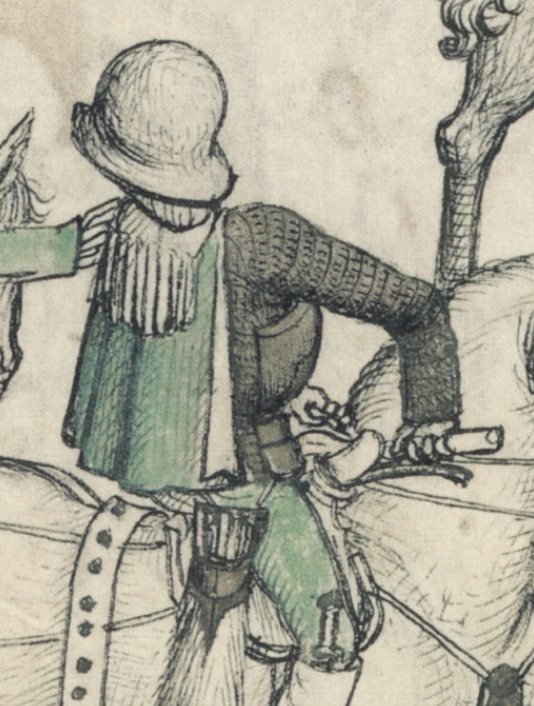
 Attachment: 942.19 KB Attachment: 942.19 KB
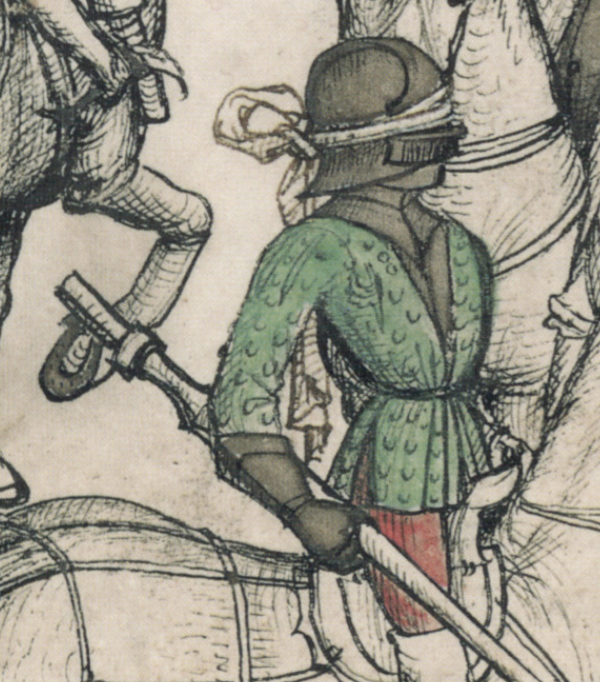
 Attachment: 43.84 KB Attachment: 43.84 KB
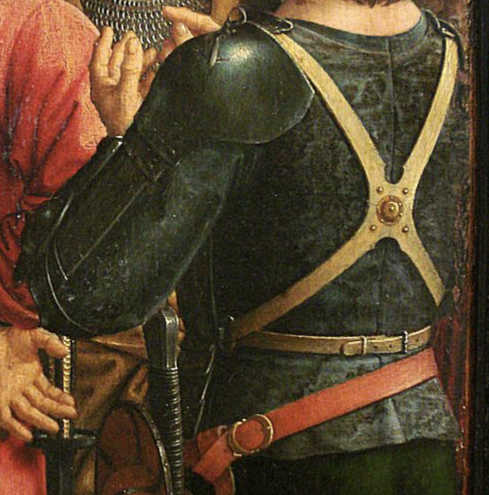
 Attachment: 270.17 KB Attachment: 270.17 KB
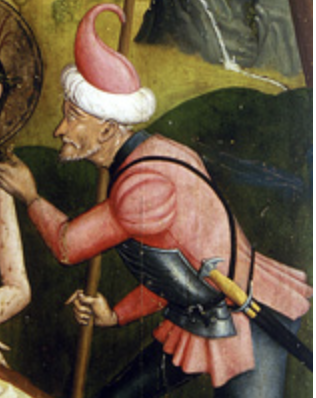
|
|
  |
 |
|
Edward Lee
|
|
  |
 |
|
Kristjan Runarsson
|
 Posted: Fri 17 May, 2019 2:25 am Post subject: Posted: Fri 17 May, 2019 2:25 am Post subject: |
 |
|
Yeah, I read that thread. I was hoping somebody had access to armoury inventories, equipment orders or something that would give a statistical picture of how common these armours were and whether the rank and file Landknecth or late 15th century 'Knecth' was equipped with back and breast or just one of these back-less breastplates. I suspect it was the latter for all kinds of reasons starting with cost and going into weight, and the fact that full plate was cumbersome to put on and a hinderance in a lot of things a foot soldier has to do.I've even seen artwork that seems to suggest that even knights sometimes chose to wear only a mail shirt and a breastplate half of a breast and back for those same reasons.
|
|
  |
 |
Pedro Paulo Gaião

|
 Posted: Sun 19 May, 2019 8:08 am Post subject: Re: Breastplates without back plates Posted: Sun 19 May, 2019 8:08 am Post subject: Re: Breastplates without back plates |
 |
|
I've seen in art, depictions of what appear to be levies and city militias wearing little more than a breastplate (no backplate) sometimes with a helmet and occasionally gauntlets. It also seems that light cavalry Frei-Lanzer/demi-lance/coustiller armor ranged from gauntlets, a mail shirt worn under a breastplate (no backplate) a sallet and occasionally a bevor to the same outfit with light arm harnesses and knee-length leg harnesses added. The lower legs being protected only by boots. By the 16th century, you sometimes see Landsknechts wearing a breastplate and backplate and a helmet of some kind and Frei-Lanzers/demi-lances/coustillers wearing a breastplate with backplate and articulated assets, mail shirt underneath (or just sleeves), gauntlets and an armet.[/quote]
I ought not to be a specialist in the given subject, but I would say there isn't a proper answer for you since we lack quantitative information on that. However, there is plenty of evidence of how these pieces would appear depending on what army or social condition we are talking about:
The first image shows a mounted crossbowman, which is bellow the rank of men-at-arms and of which couldn't afford full armor (for example, the book Lisboa e a Guerra had a royal decree stating that people with enough income to afford the weapons and full armor had be promoted from the crossbowmen class to the MAA class)
The second isn't a frontal cuirass, the whole piece is actually underneath the clothes, sometimes these hide fully or partially the cuirass (arm harness, however, is normally worn OVER the clothes). The soldier in the picture is a light cavalrymen. Both mounted crossbowmen and light cavalrymen came from somewhat mid-class citizens who couldn't afford the cost of being a propper men-at-arms. I highly recommend you read Daniel's article on German light cavalry: http://kriegsbuch.blogspot.com/2016/01/the-ap...n.html?m=1
To short the question, by 15th c. there was a trend in continental Europe of providing support cavalry to the traditional role of the MAA; this might have happened also because of the income growth of the gens de commune, who would have increased the amount of equipment but not enough to become a man-at-arms. In France, the supportive role came in the military class of the mounted coustillier, latter even the mounted archers also acquired shock cavalry roles. In Spain the traditional ginete light cavalry embraced a more shock cavalry role, then dropped its javelins, light lances and basically became indistinguished from the rest of Europe. See: http://ejercitodeflandes.blogspot.com/2013/10/jinete-ginete.html
The last two images are representing infantrymen. Veteran and more wealthy infantrymen would manage to get more pieces of armor to be more well-clad; since they couldn't afford the whole suit, they would buy or use the most important pieces for them; that's why, for example, the Jack Chains, or cadenas in Castillian, emerged. Frontline pikemen and billmen, light cavalrymen, veteran and richer archers and crossbowmen often have these partially armored fitting.
It's important to notice that the priority of pieces isn't the same in all places and in all times: who can see a preference for leg armor in 14th and 15th centuries while these basically disappeared from the military by 1500's.
In any case, I would recommend that in every case analyzed you look after if there was an expected amount of armour since this could vary a lot: apparently there wasn't a expectation for armor from the Landsknecht pikemen, though frontline pikemen and doppelsoldner necessarily HAD to be armored. I don't have the picture know, but I remember seeing an early 16th. century colored picture of a Landsknecht formation of which the rearguard was entirely composed of Zweihander-armed Doppelsoldner, all of them using cuirasses with frontal and back plates. This, I presume, was the minimum amount of armor for Doppelsoldner by this time. Have a look at the piece in my files, from another topic of this forum, it's said it was mass produced in the time of emperor Maximilian for the Landsknecht troops
Last commentaries: mail stopped being common by 1500, so except in more specific places (Hungary, Portugal etc), people would either have anything to wear or depend in the cuirasses, whether the full or the frontal ones (the latter being cheaper). Have this in mind before analyzing those periods.
1500's Dolstein description of the swedish army and german Landsknecht soldiers show that frontline pikemen wore full cuirasses, tasset, and arm harness; while both the normal pikemen and the doppelsoldner (by this time only the halberdiers, the two handers not being introduced yet) had at least the frontal cuirass.
Halberdier and dismounted Swedish MAA: https://www.pinterest.ru/pin/408279522442807645/
Pikemen exercise: https://www.pinterest.ru/pin/342203271660547734/
https://www.pinterest.ru/pin/342203271660547732/
Frontline pikemen at battle: https://www.pinterest.ru/pin/342203271660547731/
Extra: "knecht" in german doesn't mean "knight" (that would be ritter; which is different from reiter, this meaning just "cavalry").
 Attachment: 316.36 KB Attachment: 316.36 KB
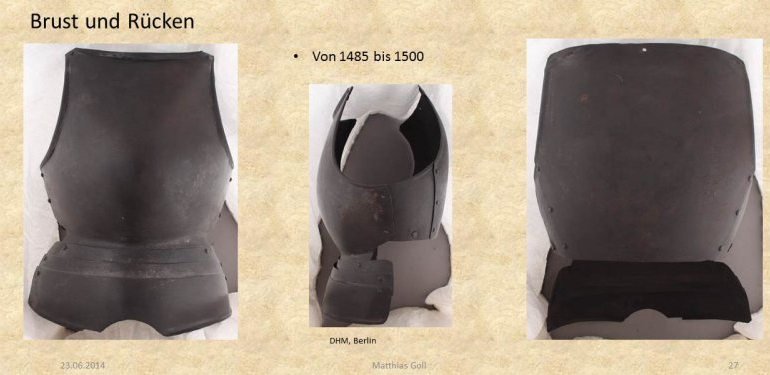
“Burn old wood, read old books, drink old wines, have old friends.”
Alfonso X, King of Castile (1221-84)
|
|
  |
 |
|
Kristjan Runarsson
|
 Posted: Mon 20 May, 2019 1:51 am Post subject: Re: Breastplates without back plates Posted: Mon 20 May, 2019 1:51 am Post subject: Re: Breastplates without back plates |
 |
|
I've seen Dolnsteins drawings and they are very interesting. However, while some of them show men in the front ranks in light plate arm harnesses, others show these men wearing only breastplates, possibly back plates and tassets. Plus, other images, like the "Schlacht vor den Toren Nürnbergs"/"Schlacht im Walde" show men on foot wearing breast only and guys on horse back wearing breast plates under a tunic and bits and pieces of plate arm armour over their tunic. Some of them wear only pauldrons and couters over the tunic. So I'm guessing they'd have worn mail arm armour under the tunic because when these guys wore a light plate arm harness the entire thing was usually worn over the tunic unless it had wide puffy sleeves to accommodate the couters. Another thing is that I have been rifling through Mathias Goll's dissertation and I found what looks like 'back plate upgrade kits' for breast only plates. and I think one of the guys in Dolnstein's drawings is actually wearing one of these (the one with an X on his back).
Finally, about mail, it was worn far into the 16th century. Generally I think a lot of cavalry began to shed full plate as early as the 1470s. The images from the Hausbuch are emblematic of that. I don't think the lancers in that book were wearing arm harnesses, the sleeves on their tunics could not accommodate the couters with sleeves that tight. They might be wearing back plates, it is impossible to tell with them wearing those tunics. After Pavia the lightening trend was only re-enforced. By the 1540s I'm seeing people in three quarter or half plate suits. I've seen images of cavalry from the 1540s and 50s wearing mail sleeves with a full plate cuirass and gauntlets, bourgonet or even an armet and by now carrying pistols and a war hammer.
P.S. I think the back plate in the last image which is tied to the mail shirt may be a fake but it gives an idea of what these retrofit back plates looked like when worn.


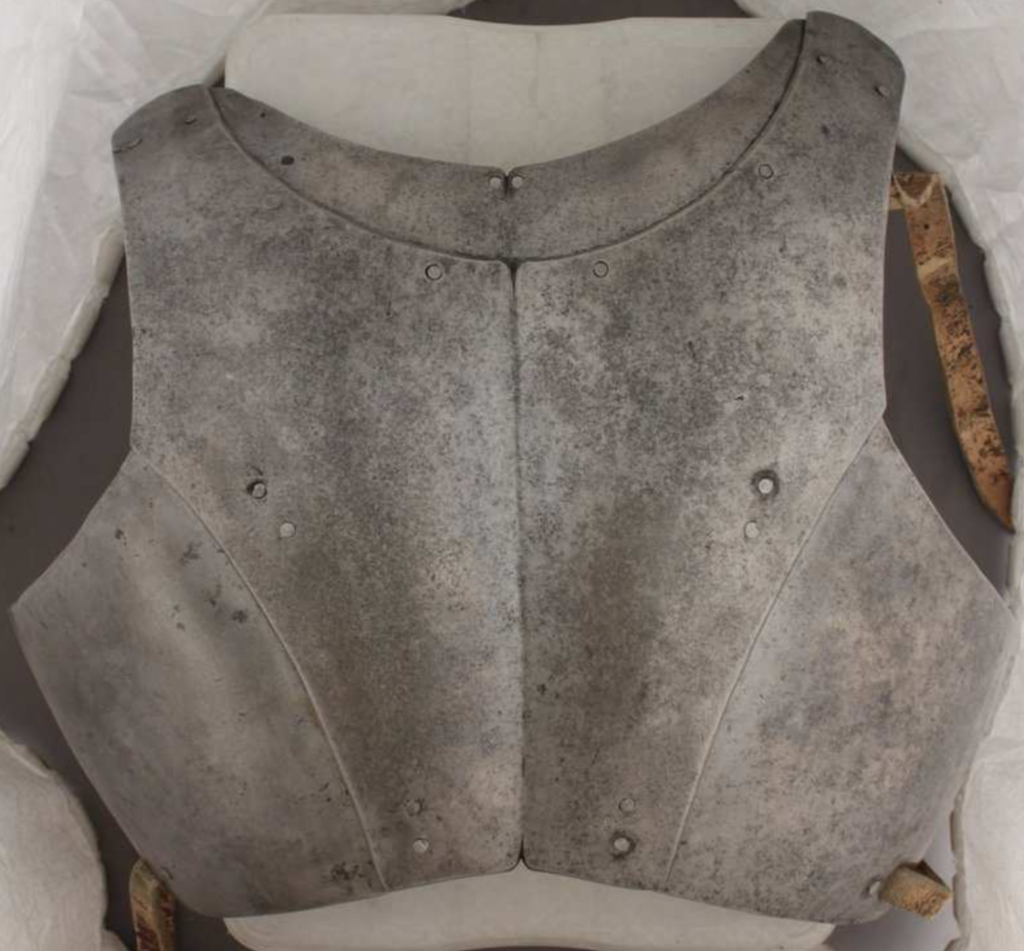
 Attachment: 45.81 KB Attachment: 45.81 KB
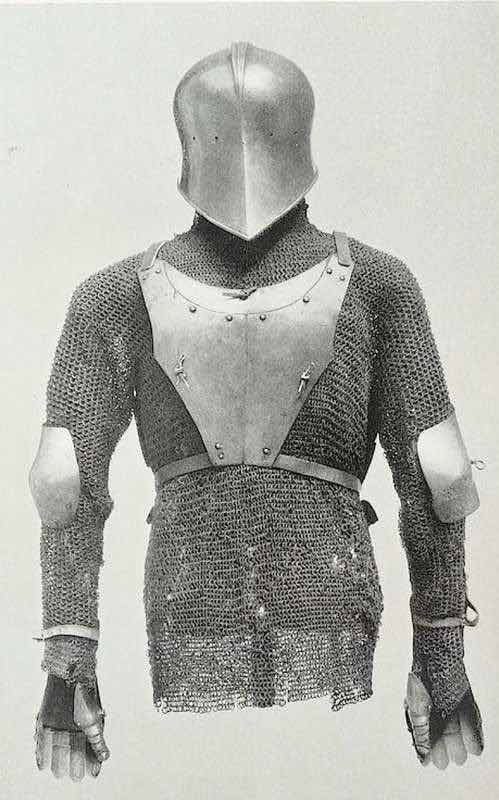
 Attachment: 671.15 KB Attachment: 671.15 KB
[ Download ]
 Attachment: 579.79 KB Attachment: 579.79 KB
[ Download ]
 Attachment: 41.52 KB Attachment: 41.52 KB
[ Download ]
|
|
  |
 |
|
Sean Manning
|
 Posted: Mon 20 May, 2019 7:47 am Post subject: Posted: Mon 20 May, 2019 7:47 am Post subject: |
 |
|
| Kristjan Runarsson wrote: | | I suspect it was the latter for all kinds of reasons starting with cost and going into weight, and the fact that full plate was cumbersome to put on and a hinderance in a lot of things a foot soldier has to do.I've even seen artwork that seems to suggest that even knights sometimes chose to wear only a mail shirt and a breastplate half of a breast and back for those same reasons. |
Its not more of a bother to be belted or pinned into a breast and back than to be strapped into a breastplate, but the back is fussy to make (its thin but deep from front to back) and the thinking in 14th-17th century Europe and Japan seems to have been that in war, if someone can really whale away at you from behind, all the armour in the world won't save you. So quite a few European soldiers relied on a shirt of mail or padded armour to protect their back. Weight was probably similar.
Soldiers in India and in the classical world usually thought differently, although one or two sources claim that some Macedonian soldiers wore the breast without the back.
weekly writing ~ material culture
|
|
  |
 |
|
Kristjan Runarsson
|
 Posted: Mon 20 May, 2019 8:14 am Post subject: Posted: Mon 20 May, 2019 8:14 am Post subject: |
 |
|
| Sean Manning wrote: | | Kristjan Runarsson wrote: | | I suspect it was the latter for all kinds of reasons starting with cost and going into weight, and the fact that full plate was cumbersome to put on and a hindrance in a lot of things a foot soldier has to do. I've even seen artwork that seems to suggest that even knights sometimes chose to wear only a mail shirt and a breastplate half of a breast and back for those same reasons. |
Its not more of a bother to be belted or pinned into a breast and back than to be strapped into a breastplate, but the back is fussy to make (its thin but deep from front to back) and the thinking in 14th-17th century Europe and Japan seems to have been that in war, if someone can really whale away at you from behind, all the armour in the world won't save you. So quite a few European soldiers relied on a shirt of mail or padded armour to protect their back. Weight was probably similar.
Soldiers in India and in the classical world usually thought differently, although one or two sources claim that some Macedonian soldiers wore the breast without the back. |
In Scandinavia mail was used into the late 16th century at least as were these back-less breastplates since they valued flexibility, mobility and lightness more than total protection for fighting in rough terrain and on ships. However, wearing these breastplates alone, or over mail, must have had some shortcomings because according to Mathias Goll's Phd thesis the above backplate style was created during the 1490s and is not contemporary with the breastplates they were worn with, so basically these backplates are retrofits to older breastplates already in armoury inventories. I suppose they quickly discovered that you want to at the very least protect your spine from the worst effects of impact weapons.
Knights also seem to have worn the breast half of a cuirass only into battle with a gambeson over a mail shirt with the breastplate being attached to the gambeson with leather straps. There are even images of royalty and high nobility basically wearing armour that is not that dissimilar from what the guys in the Hausbuch images, which I posted above, are wearing. I think it had as much to do with greater agility as it did with saving weight.
|
|
  |
 |
|
Sean Manning
|
 Posted: Mon 20 May, 2019 8:48 am Post subject: Posted: Mon 20 May, 2019 8:48 am Post subject: |
 |
|
| Kristjan Runarsson wrote: | | Knights also seem to have worn the breast half of a cuirass only into battle with a gambeson over a mail shirt with the breastplate being attached to the gambeson with leather straps. There are even images of royalty and high nobility basically wearing armour that is not that dissimilar from what the guys in the Hausbuch images, which I posted above, are wearing. I think it had as much to do with greater agility as it did with saving weight. |
Why don't you ask someone who has worn both a breast alone and a breast-and-back and see if they say that one offers any more mobility, my feeling based on my experience is no. Like I said, a sword-proof back weighs 2-3 kg, pretty similar to mail or quilted armour covering the same area.
If European soldiers felt they needed solid protection over their spines, it sure took them a long time to ask their armourers for a solid backplate. Breastplates were common in Europe by the 1360s, but the first evidence for backplates which span the whole back is in the 1410s, and until the middle of the 15th century backs tend to open up the centre. The Japanese liked a similar solution, sometimes with the spine unprotected.
Its likely that the back was the cheapest option. There is a text from Ireland at the beginning of the 16th century saying that English settlers who say they are too poor to buy a jack have to at least buy a breast and back, those are so cheap that they can't whine.
weekly writing ~ material culture
|
|
  |
 |
|
Kristjan Runarsson
|
 Posted: Mon 20 May, 2019 9:56 am Post subject: Posted: Mon 20 May, 2019 9:56 am Post subject: |
 |
|
| Sean Manning wrote: | | Kristjan Runarsson wrote: | | Knights also seem to have worn the breast half of a cuirass only into battle with a gambeson over a mail shirt with the breastplate being attached to the gambeson with leather straps. There are even images of royalty and high nobility basically wearing armour that is not that dissimilar from what the guys in the Hausbuch images, which I posted above, are wearing. I think it had as much to do with greater agility as it did with saving weight. |
Why don't you ask someone who has worn both a breast alone and a breast-and-back and see if they say that one offers any more mobility, my feeling based on my experience is no. Like I said, a sword-proof back weighs 2-3 kg, pretty similar to mail or quilted armour covering the same area.
If European soldiers felt they needed solid protection over their spines, it sure took them a long time to ask their armourers for a solid backplate. Breastplates were common in Europe by the 1360s, but the first evidence for backplates which span the whole back is in the 1410s, and until the middle of the 15th century backs tend to open up the centre. The Japanese liked a similar solution, sometimes with the spine unprotected.
Its likely that the back was the cheapest option. There is a text from Ireland at the beginning of the 16th century saying that English settlers who say they are too poor to buy a jack have to at least buy a breast and back, those are so cheap that they can't whine. |
I'm going to acquire a replica of those breasts and backs shown above, so I suppose I'll find out myself. In the mean time I can only go by period sources who say that no lesser people than the Emperor Maximilian I and several of his high nobles preferred to wear a 'Knechtishcen Harnisch' it being so much more comfortable to wear for long periods than full plate. There must be a reason people who could afford full plate chose to wear a three quarter or a half suit or even a half suit with no vambraces and even a breast with no back. Here is one example, This being Engelbrecht I van Nassau-Dillenburg and Jan IV van Nassau, on a relief made in c.a. 1475. These two were the counts of Nassau and as such not exactly destitute and yet the figure at the back is wearing what is clearly a breastplate designed for use with a back plate but he wears it strapped to a gambeson without the back plate. There must have been a reason to leave the back plate off even though he had one. Having worn chain mail over a gambeson myself for hours on end I can't imagine it was weight so it must have been something else and the only thing I can imagine is agility. That having been said we're getting a bit off topic here. All I really wanted out of this thread was to know is how common breastplate only armour was, not challenge the dogma of armour scholarship.

 Attachment: 56.77 KB Attachment: 56.77 KB
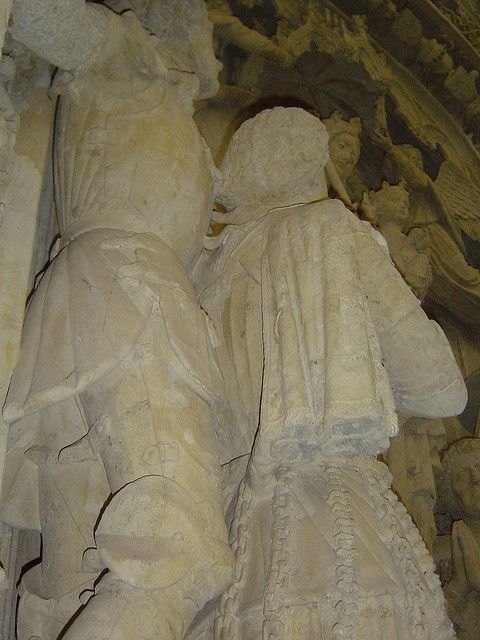
|
|
  |
 |
|
Henry O.
|
 Posted: Mon 20 May, 2019 2:31 pm Post subject: Posted: Mon 20 May, 2019 2:31 pm Post subject: |
 |
|
Something interesting I came across is that Pietro Monte actually did suggest at the start of the 1500s that for a skilled fighter in single combat it might be beneficial to leave the back parts lightly armored or even unarmored, and just not let the enemy hit him there:
"But the skilled should be otherwise armoured, especially in single combat; in this place or way of fighting we say that it is more inconvenient for someone to be too weighed down by arms than if he would leave some limbs uncovered, such as the back parts, or that they are at least lightly armoured. For he who knows how to govern himself in the way we have already prescribed can be very easily protected, to keep him from being caught by the back part, or even by the sides, so that he is not only lightly armoured on all parts, and strongly where needed."
http://mikeprendergast.ie/monte/
As far as military treatises go, even those that start to advocate lighter and less complete armor generally continue to specify both a breast and back plate for both infantry and cavalry (though the backplate would have been less thick). The idea may have been that in a pitched battle as opposed to single combat it was still too difficult to pay attention to where every blow was coming from at all times and so it was still necessary to have some all around protection in case someone unexpectedly hits you in the back.

In the section on Cuirassier training in his 1632 cavalry manual, John Cruso suggests that if you don't manage to kill or unhorse your opponent from the front, you should try to slice at his back as you ride past in hopes of cutting some of the straps that hold his pauldrons/vambraces on.
|
|
  |
 |
|
Kristjan Runarsson
|
 Posted: Tue 21 May, 2019 3:07 am Post subject: Posted: Tue 21 May, 2019 3:07 am Post subject: |
 |
|
| Henry O. wrote: | | As far as military treatises go, even those that start to advocate lighter and less complete armor generally continue to specify both a breast and back plate for both infantry and cavalry (though the backplate would have been less thick). The idea may have been that in a pitched battle as opposed to single combat it was still too difficult to pay attention to where every blow was coming from at all times and so it was still necessary to have some all around protection in case someone unexpectedly hits you in the back. |
Interesting, I suppose this is where those upgrade backplates came from. Goll says they are an afterthought, a retrofit to existing originally back-less breastplates. What I find interesting about these things is that they do not have the 'rückreifen' (the laminated skirt at the back) to protect the lower back that the regular backplates had. Later on (mid to late 16th & early 17th centuries) German infantry armour actually did away with the 'schulterkacheln' (articulated shoulder defence, spaulders) for agility reasons and I suppose the same may have applied to the rückreifen. In fact you see many soldiers dispensing with 'armzeug' (arm harnesses) as early as 1500 in Donlstein's drawings.
|
|
  |
 |
|
Kristjan Runarsson
|
 Posted: Sat 25 May, 2019 1:31 pm Post subject: Posted: Sat 25 May, 2019 1:31 pm Post subject: |
 |
|
I went through a couple of illustrated Swiss chronicles, the Luzerner Schilling and the Schodeler Chronicle (both illustrated around 1515 or later), which it turns out contain a large number of battle scenes to conduct a simple survey of the types of armour they show. The results were kinds of interesting. To sum it up in a simple typology:
Type 1: Foot soldiers and horsemen with breast and back plate. Usually with helmet and arm harnesses but often also with only helmet and breast/back but no arm harness. Occasionally a mail shirt (or sleeves+skirt) was worn underneath. A plate skirt is almost always fitted to both the breast and backplate.
Type 2: Foot soldiers and horsemen wearing only a breastplate attached with straps across the upper back, a belt around the waist and fitted with a plate skirt. Worn less often with a helmet than Type 1, sometimes with arm harness and occasionally with a mail shirt worn underneath. These breastplates are sometimes upgraded to type 1 with simple back plates that have no plate skirts fitted. A relatively small elite of the horsemen wore full leg harnesses.
Type 3: Foot soldiers mostly wearing a mail shirt and a helmet. The mail shirts are sometimes worn with a set of plate arm harnesses but no back or breastplate.
Type 4: Completely un-armoured solders who occasionally wear a helmet.
The Luzerner chronicle shows mostly Type 1 solders with the rest being mostly Type 2 with retrofitted back plates and a sprinkling of guys wearing mail shirts and others who are un armoured.
The Schodeler Chronicle, particularly volume 3 which was drawn by a more talented artist than volume 2 shows a lot more soldiers of Type 2 than the Luzerner Schilling.
It would thus seem that the breast only plates were used at a ratio of roughly 50/50 vs the breast and back version and that retrofit back plates were a frequent choice. Also, arm harnesses were usually of the half-tube type where only the upper half of the arm, both above and below the elbow, was protected. What really surprised me was the extent to which mail shirts were still used during the 1st quarter of the 16th century and the fact that some soldiers actually preferred to add arm harnesses to a mail shirt and wear no breastplate. Another surprise was the complete absence of tassets any kind except the articulated type that remained popular into the 17th century. Given Dolnstein's drawing I figured I'd see at least some rigid single plate tassets.
Finally, I agree with Matthias Goll. After at least 1450 or so, there were no sumptuary law type restrictions on what armour you could wear depending on your social class (at least in the Swiss Confederation and the Holy Roman Empire and probably Italy as well) and if there were any they were universally ignored. If you could afford it you could wear it. Wealthy and aristocratic people sometimes wore armour in the commoner style and rich rural people and rich burghers wore armour some aristocrats could not afford.

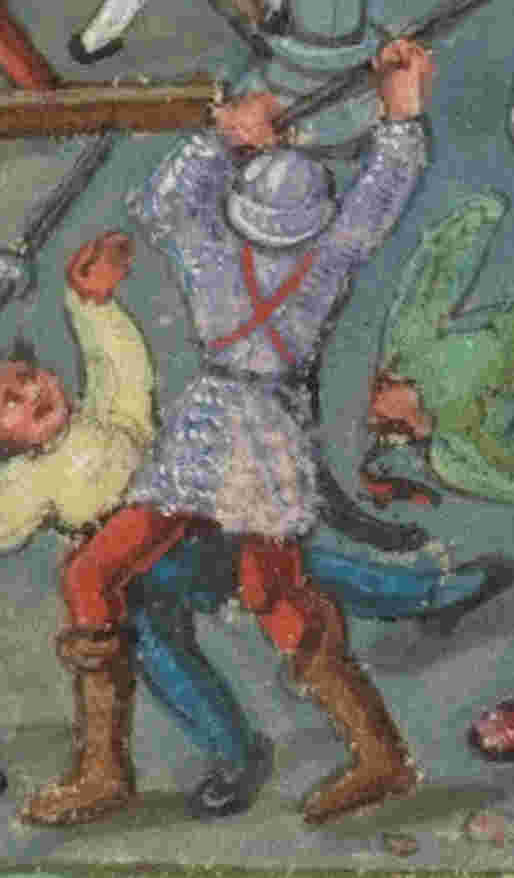

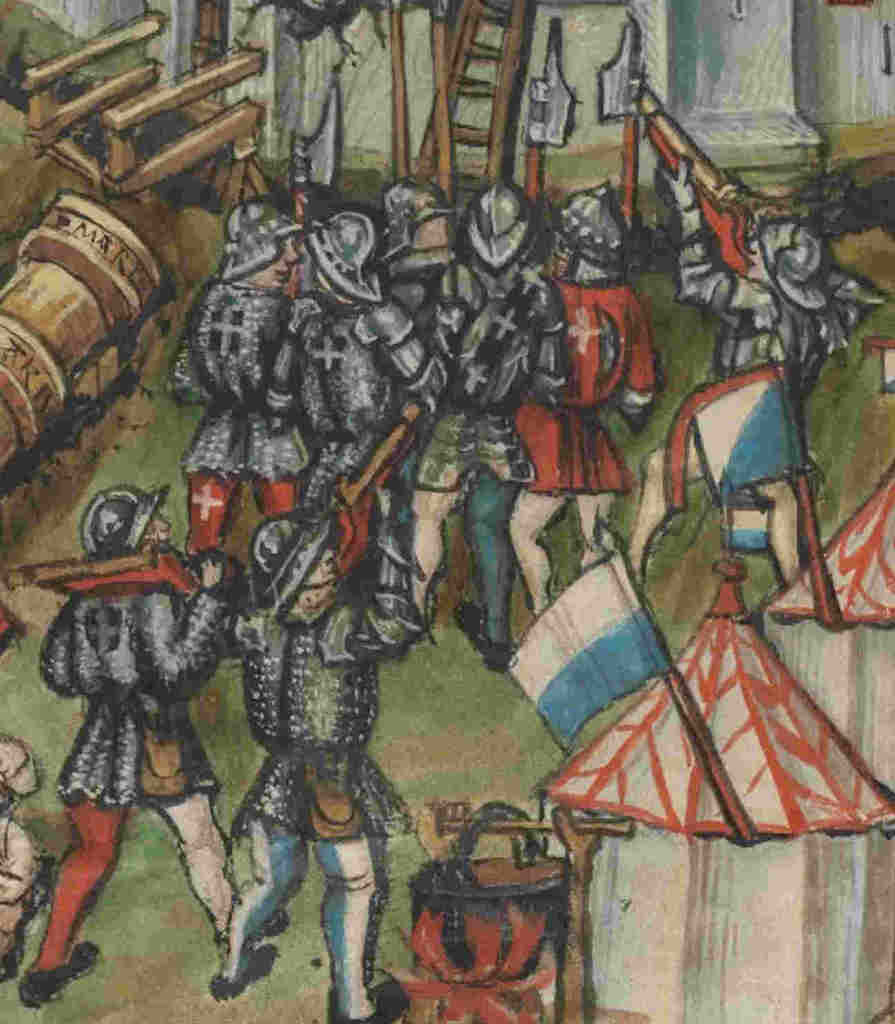
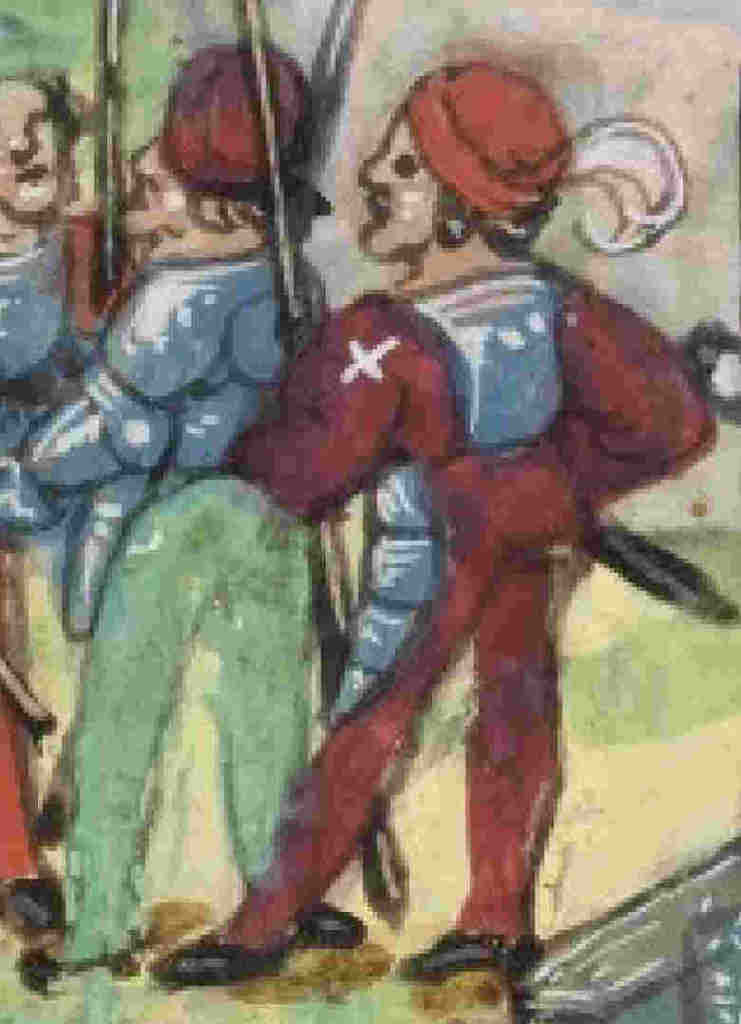
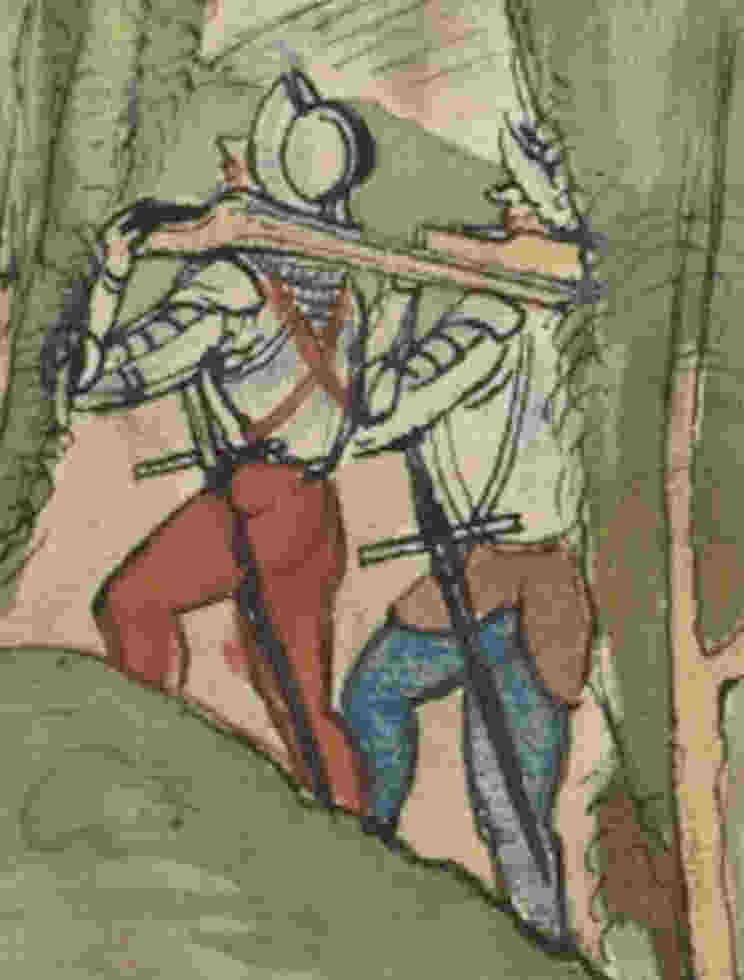
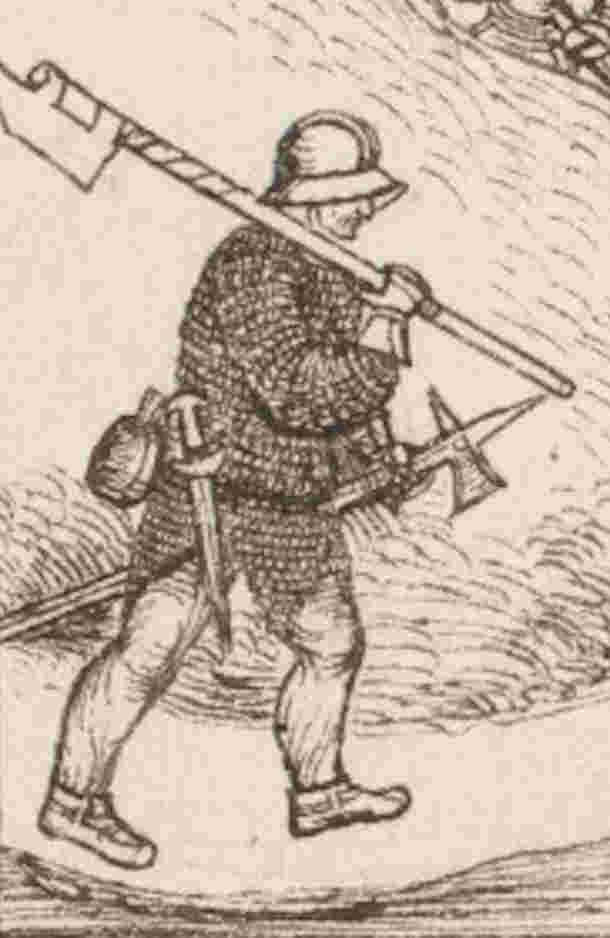
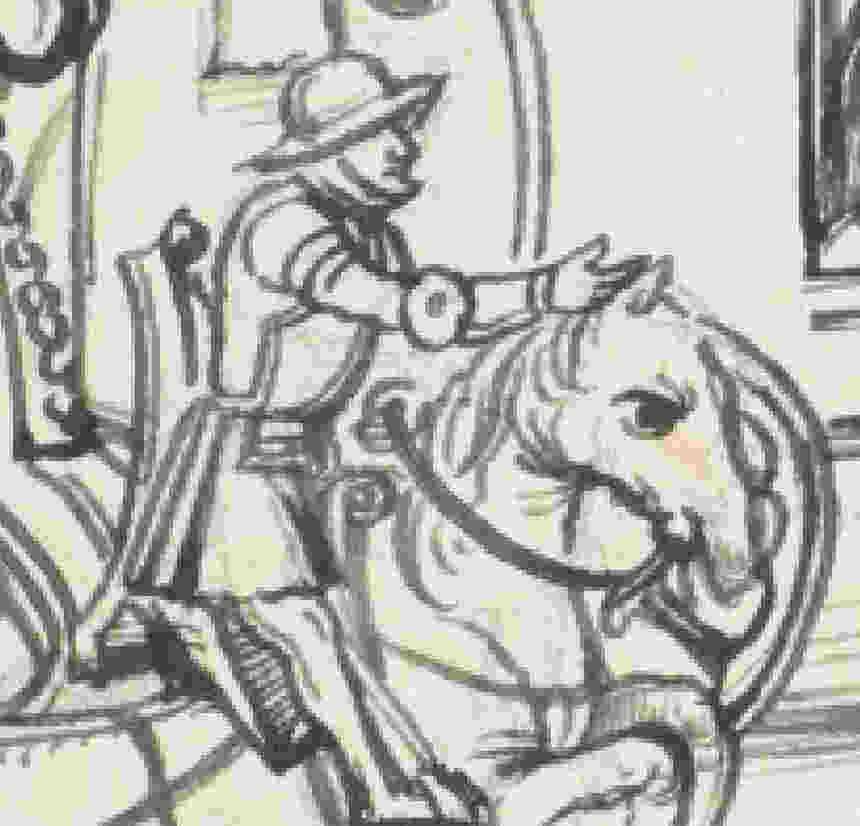
 Attachment: 40.89 KB Attachment: 40.89 KB
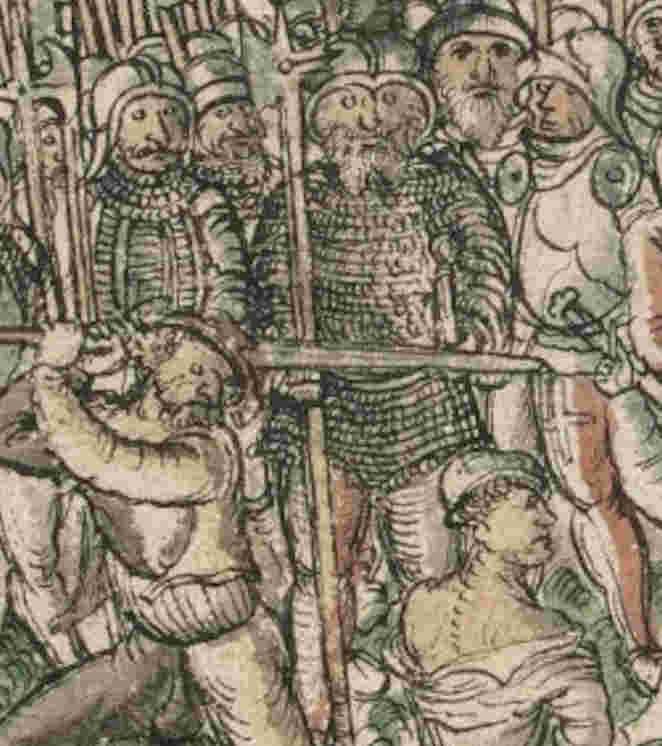
 Attachment: 41.54 KB Attachment: 41.54 KB
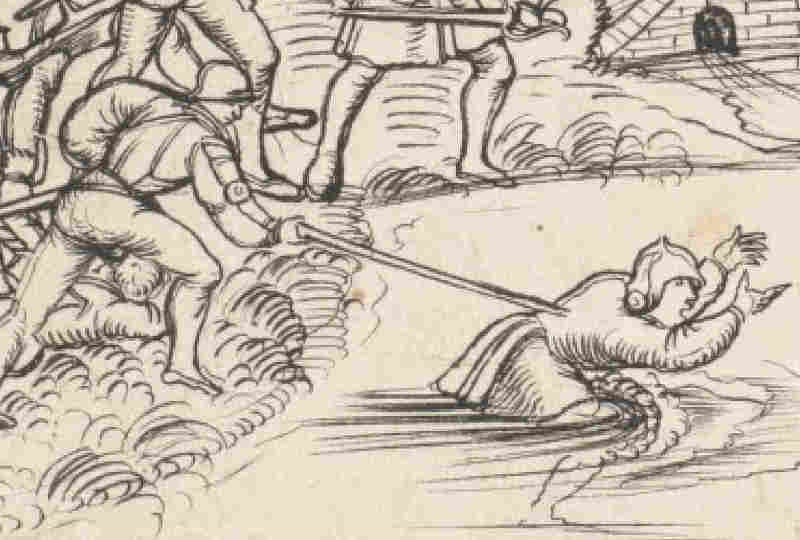
 Attachment: 26.2 KB Attachment: 26.2 KB
[ Download ]
 Attachment: 35.18 KB Attachment: 35.18 KB
[ Download ]
 Attachment: 67.79 KB Attachment: 67.79 KB
[ Download ]
 Attachment: 48.72 KB Attachment: 48.72 KB
[ Download ]
 Attachment: 33.68 KB Attachment: 33.68 KB
[ Download ]
 Attachment: 35.89 KB Attachment: 35.89 KB
[ Download ]
 Attachment: 37.61 KB Attachment: 37.61 KB
[ Download ]
 Attachment: 94.92 KB Attachment: 94.92 KB
[ Download ]
|
|
  |
 |
Pedro Paulo Gaião

|
 Posted: Fri 30 Aug, 2019 4:24 pm Post subject: Posted: Fri 30 Aug, 2019 4:24 pm Post subject: |
 |
|
| Kristjan Runarsson wrote: |
These two were the counts of Nassau and as such not exactly destitute and yet the figure at the back is wearing what is clearly a breastplate designed for use with a back plate but he wears it strapped to a gambeson without the back plate. There must have been a reason to leave the back plate off even though he had one. Having worn chain mail over a gambeson myself for hours on end I can't imagine it was weight so it must have been something else and the only thing I can imagine is agility. That having been said we're getting a bit off topic here. All I really wanted out of this thread was to know is how common breastplate only armour was, not challenge the dogma of armour scholarship.
|
All points for the fact it was more pleasant to not wear the whole armor when not in action. From what I know: the King of Portugal had a household corps of some 20-24 knights bodyguards, who were expected to follow him, watch his bedchamber and so. In 15th century, at least, it was specified the amount of armor they should be equipped with in order to protect the King at any time. It was something, but not full plate armor (I'll find the reference again, in A Guerra em Portugal em fins da Idade Média.
Add to that the fact that Fernão Lopes mentions the armor the squire Nuno Álvares Pereira was wearing during the coup in the Lisbon Palace: arm harness and plate cuisses, alonside a "belt-sword" (meaning an arming sword). Given the description, he was wearing normal garrison armor for his condition; nevertheless, though, the Queen bragged about the amout of arms he was wearing in the pallace (actually, he was intending to actually fight and depose her).
The Panells of São Vicente, another reference for mid-15th century Portuguese armor, shows a cerimonial occasion where the King and his nobles were attending a service in the Church. He wears cavalry hauberk, green-silked brigandine and jack chains in their arms and legs. The nobles are often dressed with mail and jack chains in their clothes, and swords. A guardsmen appears to have been more armor, but not much though.
Iagoba, in another thread of this forum, said "Cadenas" (ie. jack chains) were often used by castillian nobles in cerimonial and daily occasions, often having them gilded.
“Burn old wood, read old books, drink old wines, have old friends.”
Alfonso X, King of Castile (1221-84)
|
|
  |
 |
|
|
You cannot post new topics in this forum
You cannot reply to topics in this forum
You cannot edit your posts in this forum
You cannot delete your posts in this forum
You cannot vote in polls in this forum
You cannot attach files in this forum
You can download files in this forum
|
All contents © Copyright 2003-2024 myArmoury.com — All rights reserved
Discussion forums powered by phpBB © The phpBB Group
Switch to the Basic Low-bandwidth Version of the forum
|

